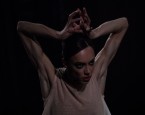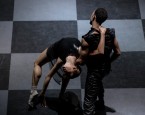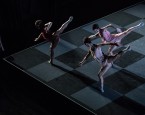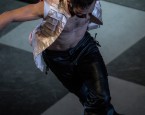
Premiere MACBETHBallet after William Shakespeare’s tragedy with the same name
The plot of Shakespeare’s Macbeth mirrors the focusing of the Renaissance on the man’s power/capacity to create her or his own destiny by making her/his own decisions. At the same time it opens depths in which decisions can be reflections of other people’s suggestions, while the power to control one’s own life can become an obsessive control of others. It is with dance that in its nature goes beyond the restraints of language that we want to emphasize that the loss of borders is inseparable from the loss of ethics, loss of one’s closest ones and finally our own selves.
The choreography of the internationally awarded Maša Kolar, with its preciseness, a rich dynamic and the complex and highly aesthetic movement of clean lines, will enable the dancers to maximally finalize and clean their dancing, but also acting technique. Besides enabling the professional advance (for dancers) and raising the degree of cultural offer in our county (for spectators), this staging would contribute towards the dethroning of the stereotype that dance is not able to present convincingly the deep and complex human stories. Finally, we would like to encourage the spectators to think of the power we aspire to, the way we acquire it and the price we pay for it.
Project realised in co-operation with
THE REPUBLIC OF SLOVENIA – EMBASSY IN ZAGREB
Running time:
The performance lasts 1 hour.
In the reception of Shakespeare’s opus, Macbeth takes place as one of the best-known tragedies, right next to Romeo and Juliet, yet, in its tragic quality it develops to the extreme, being much darker, more mystic and fatal. Since the very beginning, the history of playing this Scottish piece was shrouded in its mystic style with the myth of a curse put on its staging, even performing itself. However, the fact is that this shortest of Shakespeare’s plays is a challenge in decomposing issues, also of the staging itself. Despite numerous attempts of great Shakespearean directors and actors, there are only few successful productions.
The fact that Shakespeare himself introduced dances in his plays has not been of help for this tragedy to attract as much attention of choreographers as some other Shakespeare’s plays have, as Romeo and Juliet, A Midsummer’s Night Dream and Othello. Although this drama, that, as if in a nightmare, provides dynamic scenes of fights, hallucinations, lies and hypocrisy, setting rewarding bases for choreographic material, performances that could have ben recorded as a ballet canon work, are not so known. In the context of a ballet, Macbeth has been an inspiration for developing themes in other ballet titles, primarily in the way that many choreographers adopted motifs as those of witches, madness, superstition, absolute evil, moral fall or the motif of female evil – Lady Macbeth.
It is known that Shakespeare sometimes used dances in his plays in order to emphasise specific life metaphors in an ironic way, while in Macbeth he shows witches dancing wanting them thus to embody the notion of evil as truly as possible. However, encyclopaedias of dance give only a brief historical review of ballet with regard to this tragedy. Only few data can be found on choreographers who have undertaken a dialogue with this work, beginning from the first productions in the second half of the 17th century with Priest Josiah who choreographs dances for Sir William Davenant’s operatic version of Macbeth (1673, Duke’s Theatre, London). Galeotti Vincenzo, unlike his predecessors, choreographs a lyric version of the ballet (1816, Royal Danish Ballet, Copenhagen), while Carlo Blasis choreographs divertissements for Verdi’s opera (1847, Teatro della Pergola, Florence). In the 20th century, next to the one of Nikolai Boyrachikov (1984, Maly Opera and Ballet Theatre, St. Petersburg), the most performed remains the version by Vladimir Vasiliev and his famous duet of Macbeth and Lady Macbeth in the manner of theatrical ballet realism (1980, Bolshoi Theatre, Moscow).
The Ballet ensemble of the Rijeka CNT Ivan pl. Zajc wishes to present itself as part of a small history wheel in the development of staging of this canon work, in its contemporary ballet style as well as the contemporary composition composed for this very occasion.
Maja Marjančić
The contemporary context of artistic creation presupposes a high-quality and strong intellectual concept around which a deep decomposition of the idea and the development of its content takes place, possibly in a new and so far inestimable way. Ballet is no exception in such a development of the contemporary artistic idea or the style of work on it, so that for the last hundred years we have seen it straying from narration and the literal character.
Bearing that in mind, it was in the direction of tradition that our approach to the dramatic text of Macbeth began, in an attempt of narrative translation of the dramatic action itself into dance and movement, with the exception of supposition that in the inter-medial translating from the textual aspect into a ballet one, it is the tension of interpreting the very work that emerges. If we use the theoretic statement of Dominick LaCapra, the tension between the textual and dance media presupposes the elimination of elements: we take a part of the story and retell it faithfully, another part we change, while a part is left out. Creating a new space, our set design constructs a new interpretation, while the contemporary language of the dance and movement additionally defines the narrative quality of the work itself.
There are two main motifs in the focus of our ballet around which the action was created. One is the motif of regicide, that is, the turning over of the hierarchical and moral order, the other the development of relationship between Macbeth spouses. Macbeth’s courage and boldness in fight bears justification and admiration only within the moral and legally defined feudal order. Trained to serve the King and homeland, with his treacherous act and attacking that very superior system, he breaks the whole of the hierarchical order. The history of human civilization describes the immeasurable number of regicide cases, not also the impotence in assuming moral consequences and responsibilities that follow. It is Macbeth himself who speaks of this, “The tyrant Macbeth consciously sacrifices much, ‘As honour, love, obedience, troops of friends, I must not look to have”(V.iii.25). As he is a tyrant his rule is without substance, his crown fruitless and the sceptre barren; such a ruler only brings unnatural occurrences, undertakes a reign of terror, deprives his people of basic needs, ‘Give to our tables meat, sleep to our nights’ (III. vi. 34). … The cause of disease is in the ruler himself, who is also not serene, suffering the same torments, ‘Ere we will eat our meal in fear, and sleep in the affliction of these terrible dreams that shake us nightly.’ (III. ii. 17-19)”. In a constant crisis of identity, the character of Macbeth equalizes moral extremes of a hero with that of an offender, regardless of whether a criminal or a king.
The system of values set by Macbeth and Lady Macbeth is impossible to sustain, whether for the people around them who rebel against them or for their own selves. Her frustration in satisfying the drive for power takes them into a whirlwind of egotism where they become victims of their own passion. The coexistence of loftiness and coarseness in their relationship decomposes by the principle of dual opposition and change of psychological manifestations, from the calculated ratio to the uncontrolled madness. Lady Macbeth, as the most unwavering advocate of common sense, becomes a victim of madness, while his madness and belief in prophecies, bring Macbeth to the rational decision to keep his own position of power, even at the cost of self-destruction.
The appeal of this tragedy is in the game of illusion and reality, in the mysticism and the fighting spirit, in intimacy, madness and hypocrisy, dissolving in the times of darkness and blood. The greatest challenge for a choreographer is the dance elaboration of characters and living situations that open the repertoire of dance material from that of love, passion and hypocrisy to the one in the fighting spirit and that of cruelty, where dancers can express their corporal virtuosity in its totality, at the same time also emphasising their acting ability in embodying different mental manifestations and states.
Maja Marjančić







